A segmentation is based on a “distance-definition”.
Using StarDust, you can create very complex distance-definition. For example, the following axis can be included inside you distance-definition:
•On all continuous variables:
oNon-normalized original axis ![]() of the data: select “ED:none” inside the “Normalize” column inside the large table on the “Standardization” tab inside the
of the data: select “ED:none” inside the “Normalize” column inside the large table on the “Standardization” tab inside the ![]() parameter window (this tab is NOT accessible with the
parameter window (this tab is NOT accessible with the ![]() button, only with the
button, only with the ![]() button. See illustration:
button. See illustration: ![]()
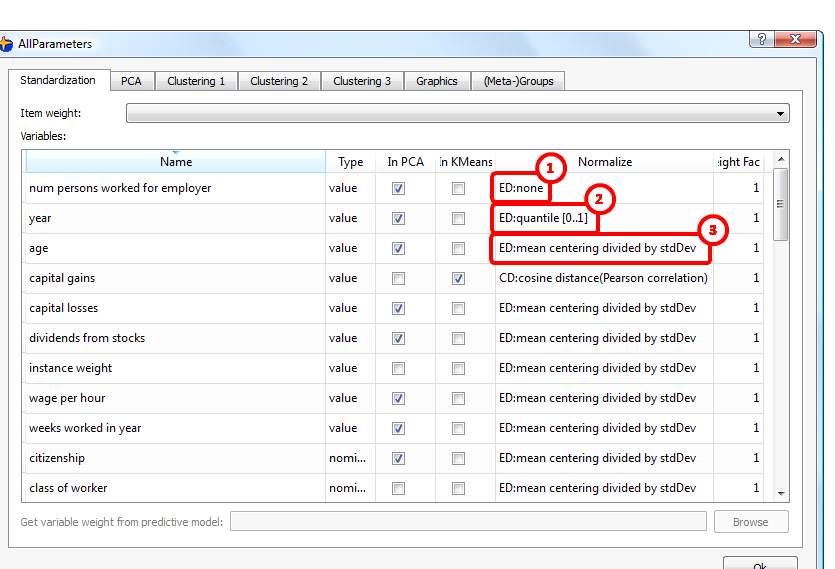
oNormalized-axis. There are two type of normalization:
▪Standard Normalization for inclusion inside an Euclidean-Distance:![]()
... where ![]() is the ith column of the dataset that has been normalized
is the ith column of the dataset that has been normalized
![]() is the ith column of the dataset
is the ith column of the dataset
![]() is the mean of the ith column of the dataset
is the mean of the ith column of the dataset
![]() is the standard devidation of the ith column of the dataset
is the standard devidation of the ith column of the dataset
Select “ED: mean centering divided by StdDev” in the same table: ![]()
▪Quantile Normalisation: ![]()
Select “ED:quantile [0..1]” in the same table: ![]()
q(x) is an operator that gives as output a number between 0 and 1.
The q(x) operator on a column C of the database is computed this way:
•Sort in increasing order all the numbers in C and remove all the duplicates. We obtain a new “sorted” column ![]() .
.
•![]()
Thus, q(x) is zero when x is the smallest number inside the column C
and q(x) is one when x is the largest number inside the column C.
The Euclidean-distance between two rows of the dataset (between the two points A and B) is ![]() and is defined this way:
and is defined this way:
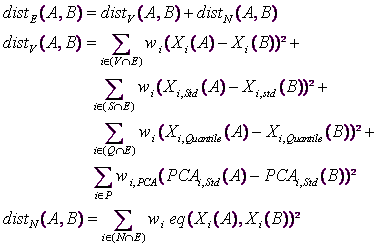
... where ![]() is a distance based on variables that only contains continuous numbers (values)
is a distance based on variables that only contains continuous numbers (values)
![]() is a distance based on nominal variables only.
is a distance based on nominal variables only.
E is the set of “active” variables to include inside the Euclidean distance-definition.
V is the set of non-normalized continuous variables
S is the set of continuous variables that have been normalized using the “Standard” normalization
Q is the set of continuous variables that have been normalized using the “Quantile” normalization
N is the set of Nominal variables
P is the set of “active” PCA axises
eq(x,y) is an operator that returns one if the string ‘x’ equals ‘y’ and zero otherwise.
![]() is the content of the column ‘i’ and row ‘A’ of the dataset
is the content of the column ‘i’ and row ‘A’ of the dataset
![]() and
and ![]() have been defined on the previous page.
have been defined on the previous page.
![]() is the
is the ![]() axis after a “Standard” normalization
axis after a “Standard” normalization
![]() and
and ![]() are user-specified (column-)weights.
are user-specified (column-)weights.
The default values are: the sets V,S,Q,E are empty, the set S contains all the continuous variables, the set P contains the first ten PCA axises, the weights ![]() and
and ![]() are all one.
are all one.
If some variables are included inside a “cosine-distance” (the C set is non-empty), then the distance-definition between two points A and B is:
![]()
...where

... and where C is the set of variables that are, at the same time, included inside the “cosine-distance” (column “normalize”) and that are “active” (column “In K-Means”).
![]() is the number of variables inside the set
is the number of variables inside the set
![]() is a user-defined parameter that specified the relative weight of the cosine-distance compared to the Euclidean-distance.
is a user-defined parameter that specified the relative weight of the cosine-distance compared to the Euclidean-distance.
![]() is the average of the
is the average of the ![]() and
and ![]() user-specified weights included inside the Euclidean-distance
user-specified weights included inside the Euclidean-distance
![]() is the mean of a vector composed by the value of the columns
is the mean of a vector composed by the value of the columns ![]() with
with ![]() on the row A
on the row A
![]() is the Standard deviation of a vector composed by the value of the columns
is the Standard deviation of a vector composed by the value of the columns ![]() with
with ![]() on the row A
on the row A
The default values are: the set C is empty, the weight ![]()
You can define the sets E,C here: ![]() You can define the sets V,S,Q,C here:
You can define the sets V,S,Q,C here: ![]() You can define
You can define ![]() here:
here: ![]()
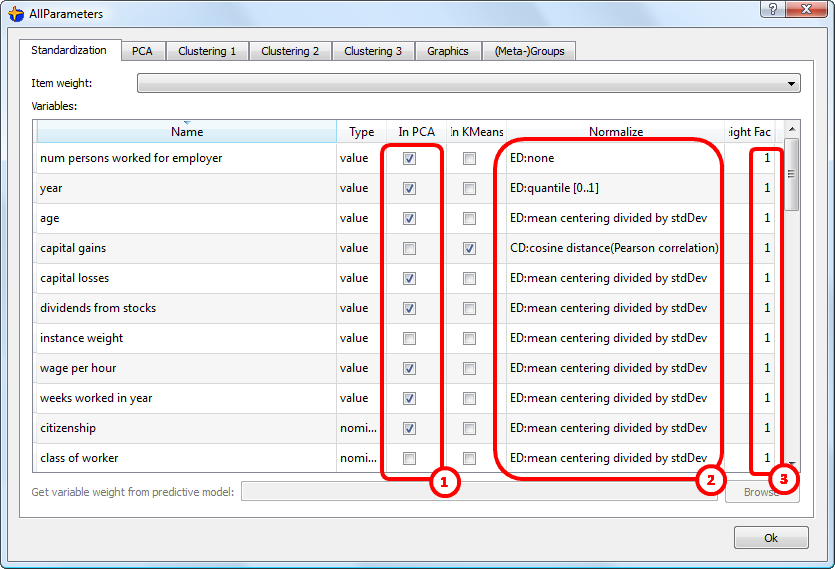
You can define the sets E,C,P here:![]() You can define
You can define ![]() here:
here:![]()
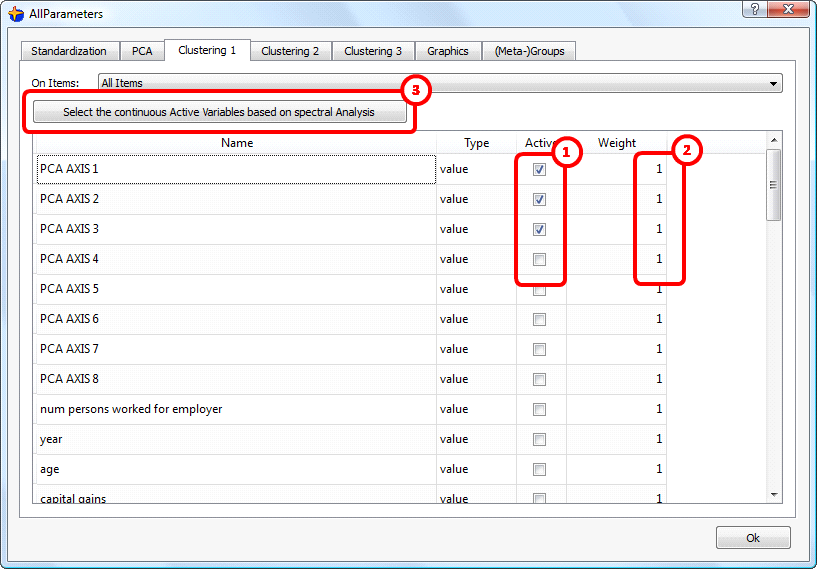
To help you to select the set P of the active PCA axises, you can click here: ![]()
When you click the ![]() button, the following window appears:
button, the following window appears:
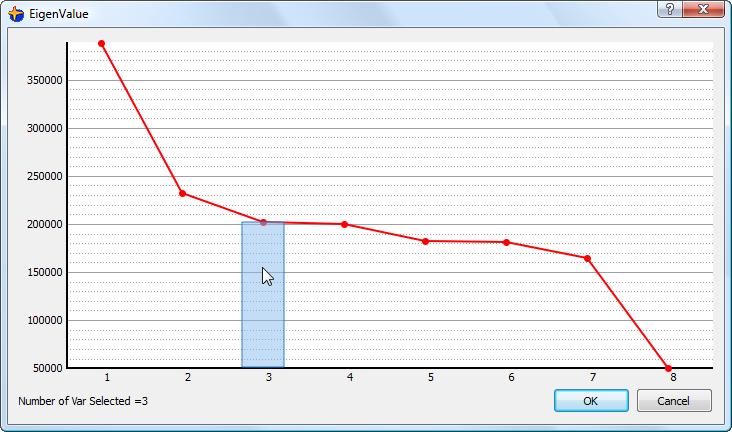
Please refer to the section 2.2.5 to know how to select to right number of PCA axises to include inside your “distance-definition”.
The default, initial setting for the “distance-definition” is equivalent to the following “distance-definition”:
